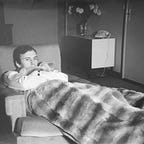24 FPS: Nenette et Boni
24 FPS is a series of film reviews written from a stream of consciousness. This one covers Claire Denis’s Locarno-winning feature — one that floats between harrowing circumstances and brief glimpses of emotional rumination as two estranged siblings come of age.
In mid-90s Marseille, a young man is the product and inhabitant of a broken household. He tends to a pet rabbit, nurtures a coffee maker like a mother to an infant, and shoots pellet guns to keep neighbouring cats away. This is Boni, an aggesively hormonal adolescent and part-time pizza artist, and — as one reviewer perfectly describes — a Brioche-munching Travis Bickle that occupies his time scrawling away into composition notebooks and feeding into a bevy of violent sexual fantasies revolving around the local baker.
Not too far from his reach is Nenette, his sister who wanders about selling phone cards so to appear as if the direction her life has taken does not seem to be completely lost. Nenette is in search of company and belonging, and it takes an unwanted pregnancy for her to re-emerge into Boni’s life, only to become an unintentionally threatening presence; an individual with no clear motive in life, let alone a clear motive to intervene with Boni’s subjective bliss. Unfortunately, in his eyes, she is no more than a catalyst that eschews the possibility of his twisted pursuits.
Right next to Beau Travail, Nenette et Boni is Claire Denis’s masterpiece. And it’s everything you’d expect a Claire Denis film to be, especially given that this was made around a time where she was still in the process of developing a film that would end up displaying her directorial skills in top form. Nenette et Boni gives us a glimpse of what Denis was able to build upon only three years following Beau Travail’s release. It takes the bleakest of circumstances for its titular characters to navigate and sets it against the backdrop of a dreamlike lens. It simultaneously delves into its atmosphere through meandering shots of muted glances, a commonality in contemporary cinema that continues to have Denis’s signature written all over it.
No scene is overly dramatic, injected within the reality that it’s firmly grounded in in order to give viewers a sense of how these people interact with their environment. Every shot and performance is as organically produced as it possibly could be, injecting a sense of calm that washes over something as absurd as one’s arousal at the sound of a grumbling coffee maker, or the oddity of blissfulness that we’re overcome with at the sight of orgasmic kneading, or the tranquility of the embarrassment of floating in a swimming pool in a dress. The editing is lucid, drifting in and out of locations like a semi-omniscient ghost. It’s as if you are witnessing these events unfold from across the street while still having the uncertainty of seeing it. That you’re not quite sure if what you’re seeing has been pulled out of a daydream, if your mind happens to be sensationalizing it through a passively blissful lens, or if that’s just how the world happens to move sometimes — at a languid and sensuous pace.
It’s films like Nenette et Boni whose nature seems to be further understood by films that followed a similar style (Buffalo 66, Julien Donkey-Boy, Drugstore Cowboy), as none of these titles manage to shy away from the brutal reality of living. In fact, its raw display of its characters’ surroundings acknowledges this. Somehow it manages to find the beauty within the rigidity of societal isolation, opening up the possibility for something so bleak to be draped in lucidity. Claire Denis has proved herself to be one of the most distinctive visual storytellers in cinematic history, and if there’s one particular thing that she has understood about her particular approach to visual imagery, it goes beyond the use of images as her primary language. It’s the nature that each of these images capture that form a language all her own, varying from one film to the next while retaining a distinctively meditative tone.
Nenette et Boni is bleakness translated into a language of beauty through every dreamlike image of its bare-bones narrative that inhabits this particular corner of France. Here, bleakness is beautiful, seductive, and enticing, and finds every opportunity to be just that without being excessively sensational, even pointing to double entendres that feed into Boni’s perverse desires without blatancy. It remains nuanced within its simplest notions, ones that speak volumes when physically expressed. Where there are longing glances to be shared are over-caffeinated fantasies waiting to burst into fruition. Faces are places, and places have faces, and wherever bleakness is understated is where the beauty lies.
